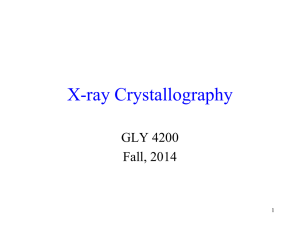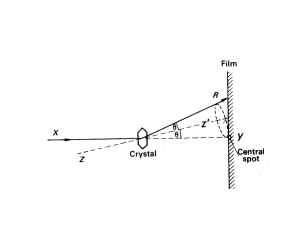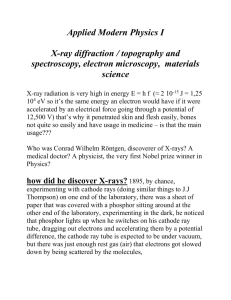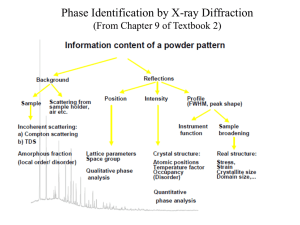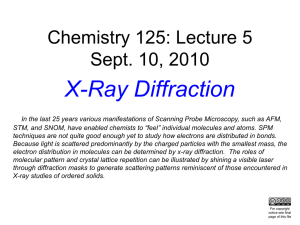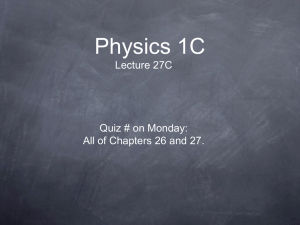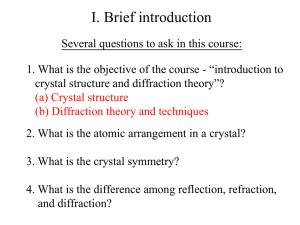Episode 530: X-ray diffraction
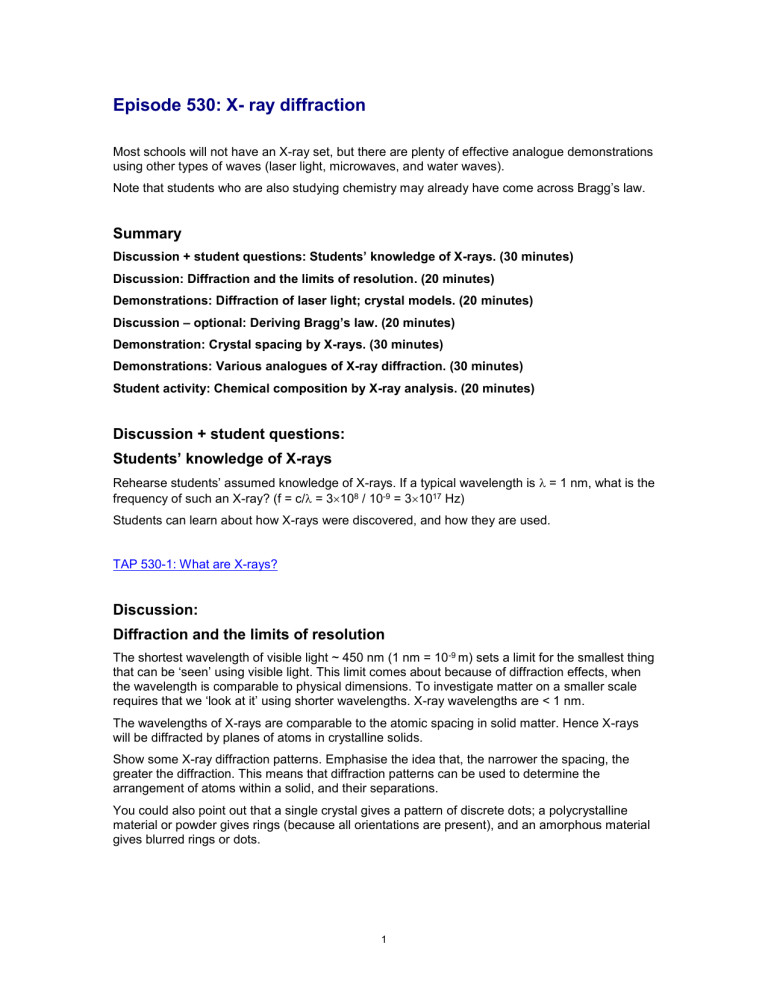
Episode 530: X- ray diffraction
Most schools will not have an X-ray set, but there are plenty of effective analogue demonstrations using other types of waves (laser light, microwaves, and water waves).
Note that students who are also studying chemistry m ay already have come across Bragg’s law.
Summary
Discussion + student questions: Students’ knowledge of X-rays. (30 minutes)
Discussion: Diffraction and the limits of resolution. (20 minutes)
Demonstrations: Diffraction of laser light; crystal models. (20 minutes)
Discussion – optional: Deriving Bragg’s law. (20 minutes)
Demonstration: Crystal spacing by X-rays. (30 minutes)
Demonstrations: Various analogues of X-ray diffraction. (30 minutes)
Student activity: Chemical composition by X-ray analysis. (20 minutes)
Discussion + student questions:
Students’ knowledge of X-rays
Rehearse students’ assumed knowledge of X-rays. If a typical wavelength is
= 1 nm, what is the frequency of such an X-ray? (f = c/
= 3
10 8 / 10 -9 = 3
10 17 Hz)
Students can learn about how X-rays were discovered, and how they are used.
TAP 530-1: What are X-rays?
Discussion:
Diffraction and the limits of resolution
The shortest wavelength of visible light ~ 450 nm (1 nm = 10 -9 m) sets a limit for the smallest thing that can be ‘seen’ using visible light. This limit comes about because of diffraction effects, when the wavelength is comparable to physical dimensions. To investigate matter on a smaller scale requires that we ‘look at it’ using shorter wavelengths. X-ray wavelengths are < 1 nm.
The wavelengths of X-rays are comparable to the atomic spacing in solid matter. Hence X-rays will be diffracted by planes of atoms in crystalline solids.
Show some X-ray diffraction patterns. Emphasise the idea that, the narrower the spacing, the greater the diffraction. This means that diffraction patterns can be used to determine the arrangement of atoms within a solid, and their separations.
You could also point out that a single crystal gives a pattern of discrete dots; a polycrystalline material or powder gives rings (because all orientations are present), and an amorphous material gives blurred rings or dots.
1
Demonstrations:
Diffraction of laser light; crystal models
Shine a laser beam at normal incidence onto a grating and note the separation of the diffracted beams. Now rotate the grating about a vertical axis. Observe that the separations of the diffracted beams increase as the effective slit width decreases. (Alternatively, use gratings with different spacing.)
Safety
Provided the laser is class 2 (less than 1 mW of visible light), the warning ‘Do not stare down the beam' is sufficient. Avoid specular reflections.
If you have crystal models handy (ask your chemistry department), look through in different directions. Many ‘planes’ of atoms reveal themselves, each with its own separation d.
Discussion – optional:
Deriving Bragg’s law
You may have to derive Bragg’s law. Beware of potential confusion: students will have met the formula for diffraction by a (transmission) grating. In diffraction from crystals the angle is defined differently, and the crystal is acting as a reflection grating. Furthermore, the theory uses reflection rather than diffraction!
X ray beam
A B C
TAP 530-2: Bragg reflection
} d
Crystal atoms
2
Demonstration:
Crystal spacing by X-rays
There are problems with using X-rays in school. However, some schools do have X-ray sets. A good alternative is to arrange a visit to a university department (Physics, Chemistry or Materials
Science) to see one in use, and to learn about contemporary applications.
You could arrange to show a determination of the crystal plane spacing in alkali halides.
Demonstrations:
Various analogues of X-ray diffraction
Here are some further analogues, for you to choose from (perhaps dependent on the equipment available).
Using laser light and diffraction gratings: Two ‘crossed’ diffraction gratings represent the atomic planes, and give an array of diffracted spots. The fact that many solids are polycrystalline and are made up of many small crystallites orientated randomly can be simulated by slowly rotating the crossed gratings. The array of diffracted spots rotates too. What would the diffraction pattern look like if the crossed gratings were rotated quite quickly to simulate all the possible orientations? (A series of rings.) Rig up two crossed gratings with an electric motor to spin them round while diffracting the laser beam. This always makes a visual impact.
TAP 530-3: Simulating X-ray diffraction
Finding the structure of DNA is perhaps the best-known use of Xray diffraction. The iconic ‘X’ shaped diffraction pattern from the helix can be simulated by diffracting a laser beam off a fine bolt thread. Using bolts of different pitches alters the angle of the ‘X’.
(See School Science Review vol 85 (312) pp 18-19.)
Use a ripple tank
TAP 530-4: Diffraction with water waves
Try using microwaves and /or a ripple tank with an array of pins
TAP 530-5: Diffraction by crystals
Student activity:
Chemical composition by X-ray analysis
An interesting use of the Bragg equation is to find the wavelength of X-rays emitted by a substance or object, so that information about its chemical composition can be found.
TAP 530-6: Where has it been?
3
TAP 530- 1: What are X-rays?
4.
3.
5.
2.
When Wilhelm R őntgen first discovered X-rays in 1895, no one had any idea what this strange phenomenon was - hence the name X-rays (although they were referred to as R őntgen rays for a while).
Visits to Egypt to see the pyramids was very much in vogue for cultured people at this time, so it is perhaps not surprising that X-rays were soon used to `see inside' Egyptian mummies.
Since then we have found out a great deal more about what X-rays are, how they are generated, their uses and their dangers.
Try this short quiz to see just how much you know about X-rays.
Questions
1. X-rays are part of the electromagnetic spectrum, but where are they positioned when the spectrum is listed in increasing wavelengths?
X-rays are frequently used to diagnose broken or cracked bones.
How is this possible?
There are a recommended maximum number of X-ray examinations that a person should not exceed in a year. Why is it necessary to limit the number?
At the dentist, a lead apron is often put onto the patient having a dental X-ray. Why is this apron made of lead?
Women having an X-ray are always asked if they might be pregnant. Why should the radiographer be interested in this?
4
Practical advice
`What are X-rays?' is mainly a recap of work done at pre-16 level to remind students of the nature of X-rays, their uses and dangers.
4.
5.
2.
3.
1.
Answers
X-rays are listed after gamma rays and before ultraviolet in the electromagnetic spectrum (in increasing wavelength). (Their wavelengths are typically 10 10 m, compared with a bit less than 10 -6 m for visible light.)
Bones show up on an X-ray photograph because the X-radiation passes through soft tissue but is stopped (absorbed) by the bones (bones are much denser). The photographic film is blackened by the X-rays going through the soft tissue and through the crack in the bone, while the bones show up as white where little X-radiation has gone through. So a better name for the ‘photograph’ is a shadowgraph
When the X-rays pass through the body they affect the body tissues.
In fact the X-rays have so much energy that they can kill cells on the way through or at least damage them. The more X-rays you have over a short period of time, the more damage is done to your body tissue from which it does not have enough time to recover.
The lead apron is to prevent X-rays entering the patient's body. The high density of lead and its high Z number prevents X-rays passing through it. (There are more dense metals
- for example gold, but that would be a little expensive in an apron!)
The danger of administering an X-ray to a pregnant woman is that the growing embryo or foetus may be damaged by the X-rays passing through it. This is particularly important because the rate of cell division in a developing baby is extremely high, and if cells are damaged or mutated by X-rays then this might cause the baby to be deformed.
External reference
This activity is taken from Salters Horners Advanced Physics, section DUTP, additional activity 3
5
TAP 530- 2: Bragg reflection
The diagram below shows X-rays being reflected from a crystal. Each layer of atoms acts like a mirror and reflects X-rays strongly at an angle of reflection that equals the angle of incidence. The diagram shows reflection from successive layers
If the path difference between the beams from successive layers of atoms is a whole number of wavelengths, then there is constructive interference.
The path difference is the distance AB + BC as above:
(AB + BC) = 2dsin θ
The reflected beam has maximum intensity when 2dsin θ = nλ
6
Practical advice
Some background information: von Laue's experiment
In 1912, Max von Laue realised that X-rays were not charged particles as they were not deflected by electric or magnetic fields, but no-one had succeeded in demonstrating that X-rays were waves by creating interference until von Laue realised that it was the extremely small wavelength which was causing the problem. He used the spaces between atoms in a crystal to diffract the Xrays and thus produced interference.
In the same year, following von Laue's discovery, William and Lawrence Bragg (father and son) varied the experiment and used a crystal to reflect X-rays and also obtained diffraction patterns.
It may be useful to remind pupils of:
TAP 322-5: Using a CD as a reflection grating
External reference
This activity is taken from Salters Horners Advanced Physics, section DUTP, additional activity 8
7
TAP 530- 3: Simulating X-ray diffraction
Introduction:
Basic X-ray diffraction involves the transmission of X-rays through a thin sample. This can be simulated using a laser through Lycopodium powder/talcum powder or tree pollen sandwiched between two microscope slides
You will need:
low-power laser
screen
pair of microscope slides (2)
stand to support slides, e.g. retort stand
powder (talc, Lycopodium ) or tree pollen
Safety
Provided the laser is class 2 (less than 1 mW for visible light), the warning ‘Do not stare down the beam' is sufficient. Avoid specular reflections.
Allergic reaction
Class members may be allergic to pollen (e.g. Lycopodium), check before use.
What to do:
Make a film of powder sandwiched between microscope slides. For best results the film should be very thin. Blowing away the excess usually achieves this.
You have seen:
The pattern produced by Lycopodium powder will be a ring pattern due to the random orientation of the scattering centres which causes the maxima to occur as a cone of a particular angle.
Talcum powder consists of larger particles so, although the pattern is due to diffraction, the pattern does not show the ring shape but simply a random arrangement of spots.
8
Practical advice
Do not breath in the dust particularly Lycopodium powder.
External reference
This activity is taken from Salters Horners Advanced Physics, section DUTP, activity 15
9
TAP 530- 4: Diffraction with water waves
Crystal diffraction can be simulated using water waves.
You will need:
ripple tank (levelled)
plane wave generator
power pack 6 V
rheostat to control speed of motor
desk lamp for illumination
barriers to provide at least 3 ‘holes’
hand held stroboscopes
What to do:
1.
2.
First set up the ripple tank with about 1 cm depth of water.
Set up a line of small barriers 5 cm from the vibrator, as shown.
There should be a gap of 2 to 3 cm between each.
3. Start the motor at a low speed (4 rev/second).
Ask
: ‘Can you see semicircular ripples emerging from the gaps? Further out, can you see waves moving out in slanting directions, as well as a wave moving straight ahead?’
Students should observe the diffraction pattern carefully, with and without stroboscopes.
Keeping the barriers arrangement the same, gradually increase the motor speed.
Ask
, ‘How does the diffraction pattern change?
!
Safety
Beware water on the laboratory floor. Make sure you have a sponge and bucket handy to mop up spills immediately.
Place the power supply for the lamp on a bench, not on the floor by the tank
10
Practical advice:
You should refer back to the work in Episode 322: Diffraction gratings and Episode 323:
Diffraction and particularly:
TAP 323-1: Ripple tank diffraction
The pattern produced with multiple gaps is less clear than the double gaps experiment but, with care in aligning the gaps, it is visible. It will help if students have first seen diagrams of sets of semicircles to represent a snapshot of waves proceeding from several gaps.
Avoid very high motor speeds, which cause unwanted vibration of the barriers.
The spacing of nodal lines will decrease as the wave frequency increases
The following Applet can be set for a triple slit, (on the set up menu pick triple slit): http://www.falstad.com/ripple/index.html
this may be simpler and easier to see than on the ripple tank
!
Safety
Beware water on the laboratory floor. Make sure you have a sponge and bucket handy to mop up spills immediately.
Place the power supply for the lamp on a bench, not on the floor by the tank
Technical notes
You need 2 large barriers and 6 small barriers
The hand stroboscope is a disc of hardboard or card with a simple pivot at its centre, so that the disc can be kept spinning by hand.
The disc has a finger hole, off-centre, to enable the user to keep it spinning. It has narrow slits on its face, near the rim. The slits are evenly spaced and 12 slits are best
This simple stroboscope enables students to 'freeze' repetitive motions – or to slow them down for closer study. For example, continuous ripples are easier to see by using a stroboscope, especially those ripples with higher frequencies. By viewing a vibrating object through the slits, students can calculate the frequency of a vibration.
The stroboscopes are less likely to judder while rotating if the bearing is not too tight and the handle is held loosely.
11
External references
This activity is taken from Salters Horners Advanced Physics, section DUTP, activity 17 and http://www.practicalphysics.org/
12
TAP 530- 5: Diffraction by crystals
Introduction:
This effect of scattering from successive layers can be shown with the ripple tank and a `bed of nails' - optical pins in a 1 cm array glued into a matrix board and placed in a ripple tank.
Microwaves can also be used to show the effect of adding layers
You will need:
ripple tank (levelled)
plane wave generator
power pack 6 V
rheostat to control speed of motor
desk lamp for illumination, a special ripple tank lamp is better: the filament can be set parallel to the ripples.
bed of nails
microwave transmitter and receiver
wax lenses to concentrate beams
polystyrene ceiling tiles
What to do:
This effect of scattering from successive layers can be shown with the ripple tank and a `bed of nails' i.e. optical pins in a 1 cm array glued into a matrix board and placed in a ripple tank. Plane waves should be incident on the nails at an angle, with the diffraction pattern appearing at the same angle on the opposite side of the bed of nails. The precise depth of water at which this works best depends on the thickness of the perspex and the nail length used. You will need to experiment.
With microwaves, first show that a single polystyrene tile used as a mirror produces a moderate reflected signal irrespective of the angle of incidence. If a second tile is mounted parallel to the first and separated from it by a few cm, then there is a reasonable reflected signal at an angle that satisfies the Bragg equation, e.g. if d = 5 cm then n = 1, λ = 3 cm leads to sin θ = 0 : 3, y =
17 : 5 8 O . The signal is noticeably weaker at other angles. Add further regularly-spaced tiles.
You have seen:
A regular array produces a diffraction pattern.
Reflection from surfaces in parallel satisfies the Bragg equation.
Adding further regularly-spaced tiles makes the reflected signal sharper.
13
Practical advice:
The microwave equipment can be set up without the wax lenses, however, they will improve results if set up correctly.
Technician’s note:
To make the bed of nails, use a piece of plain matrix board about 10 cm to 15 cm with optical pins glued in at approx. 1 cm intervals to create a square matrix.
External reference
This activity is taken from Salters Horners Advanced Physics, section DUTP, activity 17
14
TAP 350- 6: Where has it been?
The Coppergate Helmet was subjected to X-ray diffraction analysis (XRD) in order to determine what it was made from and the likely conditions in which it was buried. Study the relevant X-ray diffraction spectra and write a short report on the deductions that can be made.
X-ray diffraction spectra
Nowadays most X-ray diffraction analysis is done with a goniometer, a device in which the variation of intensity of the diffracted X-radiation is measured by scanning an ionisation detector through a range of angles - usually 0 O (straight through) to 100 O - but photographic detection is still also used. The goniometer spectrum for iron (II) carbonate is shown in Figure (a) together with the photographic film equivalent in Figure (b). (The XRD spectra in this activity were kindly made available by English Heritage.)
Note that in Figure (b) the dark lines indicate a high intensity of diffracted X-radiation. Sometimes you will find white lines on a black background - it depends on whether the negative or the positive print is used.
Be aware that diffraction information can be displayed in different ways. The records shown here involved scanning from just over 90 O to 0 O , but you may come across others which show spectra fro + 90 O to 0 O to 90 O or more, symmetrical about 0 O .
The Coppergate Helmet
As you might expect, all the metals on the helmet corroded to some extent while it was buried.
The corrosion products revealed during XRD analysis provided evidence about the original materials and the conditions where the helmet had been buried. The diagram below shows the
XRD spectra of some common corrosion products.
15
Bornite (Cu
5
FeS
4
)
This is a corrosion product of iron and copper alloy artefacts when buried on waterlogged sites.
Chalcopyrite (CuFeS
2
)
This is also a corrosion product of iron and copper alloy artefacts when buried on waterlogged sites.
Siderite (FeCO
3
)
This is a corrosion product of iron. It is found where there is, or has been at some time, a high concentration of carbonates in the water. Typical sources of these are plaster and mortar from earlier Roman buildings that have long since been demolished.
Vivianite (Fe
3
(PO
4
)2 8H
2
O)
This is a corrosion product of iron which is found where the artefact has been buried alongside phosphates from bone and excreted waste.
The XRD spectra in below are from two different parts of the Coppergate Helmet.
Use the XRD spectra for corrosion products and the two spectra A and B above to report
on what those parts of the helmet were made of,
together with the conditions in which it had been buried.
16
Practical advice
Archaeologists examining the Coppergate Helmet used X-ray diffraction (XRD) to investigate the conditions in which it had been buried. They used XRD to examine the corrosion products in small samples of the helmet, and compared their spectra with those of corrosion products produced in known conditions.
Students are provided with X-ray spectra from two samples of the helmet, and the spectra of four corrosion products together with information about the conditions that give rise to such products.
Their task is to identify the corrosion products found in the helmet and hence to deduce the nature of the original materials and the conditions in which they had been buried.
Answers
X-ray diffraction spectrum A on the Activity Sheet shows that the corrosion sample is made up of siderite and vivianite. This indicates that the material that had corroded was made of iron. It also shows that, at some time, it was buried alongside organic phosphates probably produced from bone or excreted waste. In addition, the ground water around it had, at some time, a high concentration of carbonates, possibly as a result of demolition of earlier Roman buildings that had been built with plaster and mortar.
XRD spectrum B shows that the corrosion sample is made up of bornite and chalcopyrite. This indicates that the material that had corroded was an iron and copper alloy, and had been buried in a waterlogged area.
External reference
This activity is taken from Salters Horners Advanced Physics, section DUTP, activity 18
17
